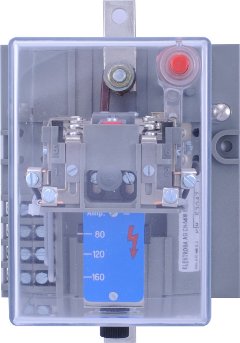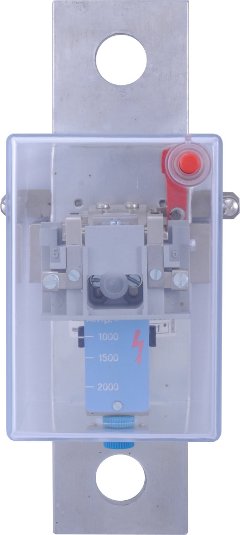Description

Fig 1 Var. 1-16

Fig 2 Var. 41-44
The overcurrent and undercurrent relays type MAS-2 are instantaneous primary relays.
Their operating time is about 0.01 sek.
The accuracy of pick-up is about + – 5% of the set value.
The relays are largely proof against short-circuit.
Relays for ratings up to 800 Amp. Are mounted on a slab of insulating material (Fig.1).
Relays rated 1200, 1600 and 2500 Amp. are designed for busbar mounting (Fig.2).
All relays have a transparent cover.
The magnetic system consists of U-shaped iron core with hinged armature.
The latter actuates the contacts.
The overcurrent relays can be equipped with a mechanical latch and indicator flag, which can be reset by a button.
(Version with display case door on request).
MAS-2 relays comply with the requirements of VDE 0660.
The clearances and creepage distances within the relay comply with the requirements laid down for rated voltages of 2400V d.c and 2000 V a.c (VDE 0110, group C).
The relays are tropicalized.
CB TEST CERTIFICATE (pdf)
60947-1(ed.3);am2
60947-2(ed.2);am1;am2
60947-5-1(ed.2);am1;am2
Applications
The overcurrent relays are used to protect d.c equipment againstshort circuits.
Owing to the rapid tripping characteristic, they can also be used to protect semiconductor assemblies (thyristors, diodes, etc.).
Also d.c machines are protected against harmful overcurrents and commutator flashover which often accompanies them.
Overcurrent relays can also be used to monitor currents during starting and braking operations.
A further application is for monitoring the current during starting and braking operations. In that case the relays are so designet that their dropout current bears a definite relationship to their pickup current.
The following ratios can be provided:
- Dropout current 25% of pickup current up to
- Max. dropout current 75% of pickup current.
The undercurrent relays are used to monitoring direct currents, especially the excitation currents of d.c. motors. As soon as the value drops below the setting, they trip the circuit-breaker.
The relays are mainly used in industrial drive systems and for traction installations.
